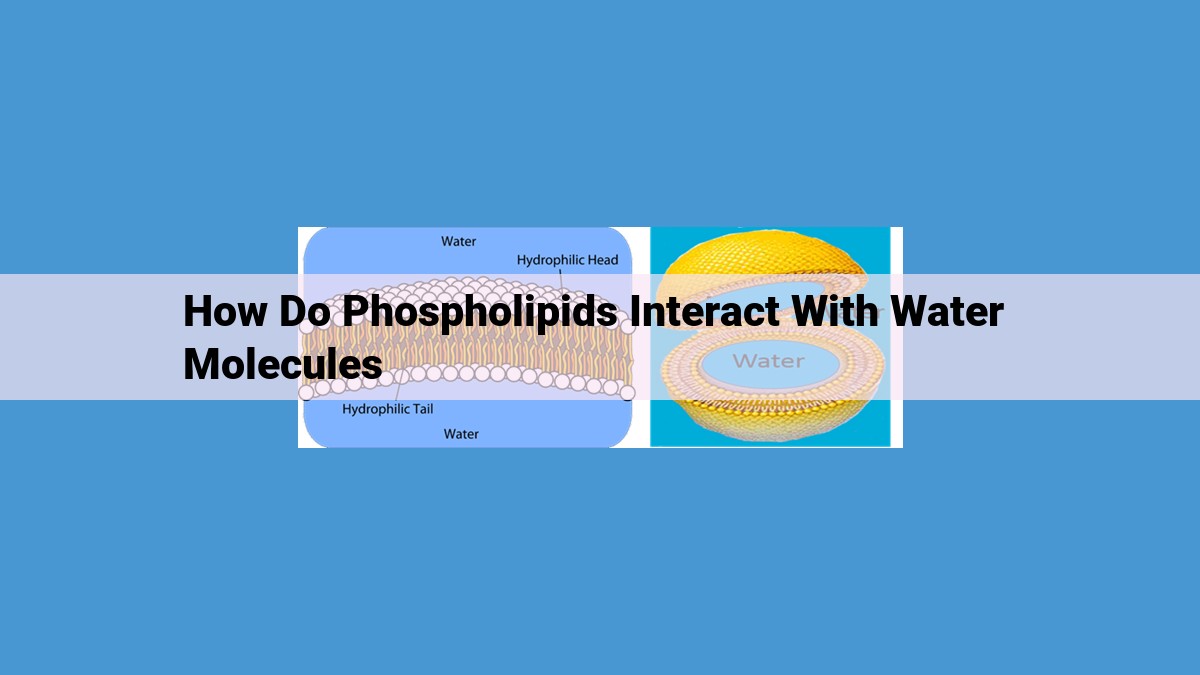Phospholipids are unique molecules that exhibit a dance of interactions with water. Their amphipathic nature, with both hydrophobic and hydrophilic regions, allows them to form lipid bilayers in water, creating a dynamic and impermeable barrier. This structure is essential for the integrity of cell membranes. Phospholipid interactions also play a crucial role in the formation of micelles and liposomes, with applications in detergent properties and nanotechnology. These interactions highlight the significance of phospholipids in biological processes, shaping cellular functions and providing a foundation for understanding biological systems.
Understanding Phospholipids: The Building Blocks of Life’s Membranes
In the intricate world of biochemistry, phospholipids play a pivotal role in shaping the structure and function of cells. These fascinating molecules are the fundamental components of cell membranes, acting as gatekeepers that regulate the movement of substances in and out of cells.
Phospholipids consist of two distinct regions: a hydrophobic “tail” and a hydrophilic “head.” The tail is made up of fatty acids that repel water, while the head is composed of a phosphate group and other polar molecules that attract water. This unique amphipathic nature allows phospholipids to form a remarkable structure known as a lipid bilayer.
Imagine a flattened sandwich with two slices of bread representing the hydrophobic tails and a layer of jelly in between representing the hydrophilic heads. This is the basic architecture of a lipid bilayer. The hydrophobic tails face inward, shielding the cell from water, while the hydrophilic heads face outward, interacting with the surrounding water environment.
Phospholipids in Water: A Molecular Tango
Imagine a world of tiny molecules, each playing a crucial role in the symphony of life. Phospholipids, the building blocks of cell membranes, are such molecules. Dive into their fascinating world and witness their dance in the realm of water.
Amphipathic: The Dual Nature of Phospholipids
Phospholipids possess a unique structure, resembling tiny umbrellas. Their heads are hydrophilic, or water-loving, while their tails are hydrophobic, or water-hating. This amphipathic nature grants them the ability to interact with both aqueous and non-aqueous environments.
Lipid Bilayer Formation: A Dance of Self-Assembly
When phospholipids encounter water, they orchestrate an elegant dance. Their hydrophilic heads reach out into the water, while their hydrophobic tails turn away from it. This creates a lipid bilayer, a double layer of phospholipids that acts as a barrier between aqueous environments.
The Significance of Lipid Bilayers: A Membrane of Life
Lipid bilayers are not just passive barriers. They are dynamic structures that form the foundational membranes of every living cell. These membranes regulate the entry and exit of substances, maintain cellular identity, and facilitate communication between cells. Their fluidity and flexibility allow cells to adapt to changing environments and carry out their vital functions.
In summary, phospholipids in water engage in a breathtaking dance, driven by their amphipathic nature. This dance leads to the formation of lipid bilayers, which are essential components of cell membranes and play a pivotal role in the intricate world of biology.
The Unseen Helpers: Practical Applications of Phospholipid Interactions
Phospholipids, the building blocks of cell membranes, are not just passive barriers but also dynamic molecules with a remarkable ability to interact with their surroundings. Beyond their crucial role in cell structure and function, phospholipid interactions find diverse applications in our daily lives.
Micelle Formation and Detergent Properties
When phospholipids are dispersed in water, they form micelles, spherical structures with hydrophilic (water-loving) heads facing outward and hydrophobic (water-hating) tails tucked inward. This amphipathic behavior allows phospholipids to trap oil and grease molecules, making them excellent detergents. Micelles are essential components of laundry detergents, dish soaps, and cleaning products, effectively removing dirt and stains.
Liposomes: Nanocages for Targeted Delivery
Liposomes are spherical enclosures formed by a double layer of phospholipids. Their unique structure allows them to encapsulate various substances, such as drugs, cosmetics, and nutrients. Liposomes act as nanocages, protecting their contents from degradation and delivering them directly to specific target cells. This targeted delivery system revolutionizes drug delivery, increasing drug efficacy while minimizing side effects.
Implications for Biology
The ability of phospholipids to form micelles and liposomes has profound implications for biology. Micelles facilitate the digestion and absorption of fats in our digestive system. Liposomes are used to transport nutrients across cell membranes and to deliver vaccines and gene therapies directly to target cells. By understanding and harnessing these interactions, scientists develop innovative solutions in medicine, biotechnology, and beyond.
Putting It All Together: The Implications for Biology
Phospholipids, with their remarkable ability to dance in water, play a pivotal role in the very fabric of life as we know it. They form the foundation of biological membranes, dynamic and essential boundaries that encapsulate and protect the cells that make up all living organisms.
Biological Membranes: The Envelopes of Life
Biological membranes are delicate yet resilient barriers that define the boundaries of cells. Composed primarily of phospholipids, these membranes regulate the flow of materials in and out of cells, ensuring their proper functioning. They act as gateways, allowing essential nutrients to enter while keeping harmful substances out.
Phospholipid Interactions in Cellular Processes
Beyond their role as structural elements, phospholipids participate in a multitude of crucial cellular processes. Their amphipathic nature allows them to form specialized structures, such as micelles and liposomes. These structures perform vital functions, including the solubilization of hydrophobic molecules and the delivery of drugs and other therapeutic agents.
Phospholipids, seemingly simple molecules, are the unsung heroes of biology. Their remarkable interactions with water give rise to biological membranes, the guardians of life, and enable a myriad of cellular processes. Understanding these interactions provides us with a deeper appreciation for the intricate workings of the living world and opens up avenues for new discoveries and applications in medicine and beyond.
